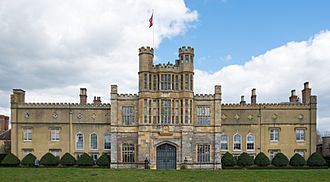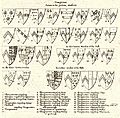Coughton Court facts for kids
Quick facts for kids Coughton Court |
|
|---|---|

Coughton Court
|
|
| General information | |
| Type | Stately home |
| Location | Warwickshire |
| Coordinates | 52°14′37″N 1°52′48″W / 52.2435°N 1.880°W |
| Completed | Built c.16th century |
| Owner | in the care of the National Trust |
Coughton Court is a beautiful old English country house. It is built in the Tudor style. You can find it in Warwickshire, between Studley and Alcester. This house is very important, so it is a Grade I listed building.
The house has a long front with a crenellated roof, which looks like castle walls. This part faces the main road. In the middle is the Tudor Gatehouse, built after 1536. It has cool hexagonal towers and special oriel windows. These windows stick out from the wall. The Gatehouse is the oldest part. Newer parts of the house are on its sides. These parts are in a style called Strawberry Hill Gothic. This style became popular because of Horace Walpole.
Contents
History of Coughton Court
The Throckmorton family has owned the Coughton estate since 1409. They got the land by marriage to the De Spinney family. Sir George Throckmorton rebuilt much of Coughton. He was a favorite of King Henry VIII. Sir George spent most of his life making Coughton grander. He even dedicated the big gatehouse to King Henry VIII.
Sir George was involved in King Henry's divorce from his first wife, Catherine of Aragon. He supported the Queen and was against the English Reformation. This was a time when England changed its main church. In 1549, Sir George planned the windows for the great hall. He wanted to show the family's history through the coats of arms of his ancestors.
After Sir George died in 1552, his oldest son, Robert, took over Coughton. The Throckmorton family were Catholics. At that time, Catholics faced difficulties in England. The house has a secret priest hole. These were hidden spaces where Catholic priests could hide. This was important when laws made it hard for Catholics to practice their faith.
Coughton Court also played a part in two famous events in English history. These were the Throckmorton Plot of 1583 and the Gunpowder Plot of 1605. The Throckmorton Plot was a plan to harm Queen Elizabeth I. The Gunpowder Plot was a plan to blow up the Houses of Parliament. The Throckmorton family was not directly involved in the Gunpowder Plot. But some of the people involved rode to Coughton after the plot was discovered.
The National Trust has owned the house since 1946. However, the Throckmorton family still lives there. They have a special agreement to lease the house for 300 years. The current residents are Magnus and Imogen Birch Throckmorton.
The house is open for visitors, but not all year. It has large grounds with a beautiful walled garden, a river, and a lake. The house recently underwent major roof repairs. This project started in Autumn 2023 and was completed by Summer 2025. It cost £3.3 million. The work fixed key parts of the roof and improved the building. The Wolfson Foundation and donations helped pay for this work.
The family used to manage the property for the National Trust. But in 2007, the National Trust took over management. The agreement is reviewed every 10 years. The family is expected to manage the property again in 2026.
Building Style of Coughton Court
The gatehouse at Coughton was built around 1536. It was built after the Dissolution of the Monasteries Act in 1536. Like other Tudor houses, it was built around a central courtyard. The gatehouse was used for deliveries and coaches to enter the courtyard.
One expert, Geoffrey Tyack, called the gatehouse "a dazzling monument to family pride." He noted its corner towers, large windows, and castle-like roof. These features make it look very grand. The gatehouse has oriel windows in the English Renaissance style. Later parts of the house on its sides are in the Strawberry Hill Gothic style.
One of the tower turrets has a priest hole. These are two secret spaces, one above the other. They were found again in 1858. A rope-ladder was still there, used to get into them. The courtyard used to be closed on all four sides. But in 1780, the part opposite the gatehouse was taken down.
After the Roman Catholic Relief Act was passed in 1829, the Throckmorton family could afford big building projects. This allowed them to change the look of the west front of the house.
Gallery
-
Family coats of arms shown in windows of Coughton Court, by Wenceslaus Hollar
See also
 In Spanish: Coughton Court para niños
In Spanish: Coughton Court para niños
- Hampton Court Palace
- Throckmorton baronets
Other sources
- Coughton Court (1979) Booklet for National Trust by J Lees-Milne.
External links
- Official website: https://www.coughtoncourt.co.uk
- Coughton Court at nationaltrust.org.uk
- Wikidata List of Paintings at Coughton Court







